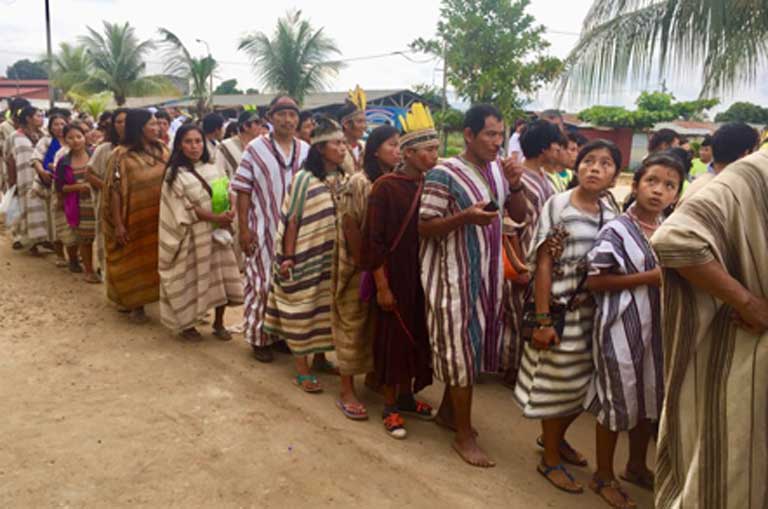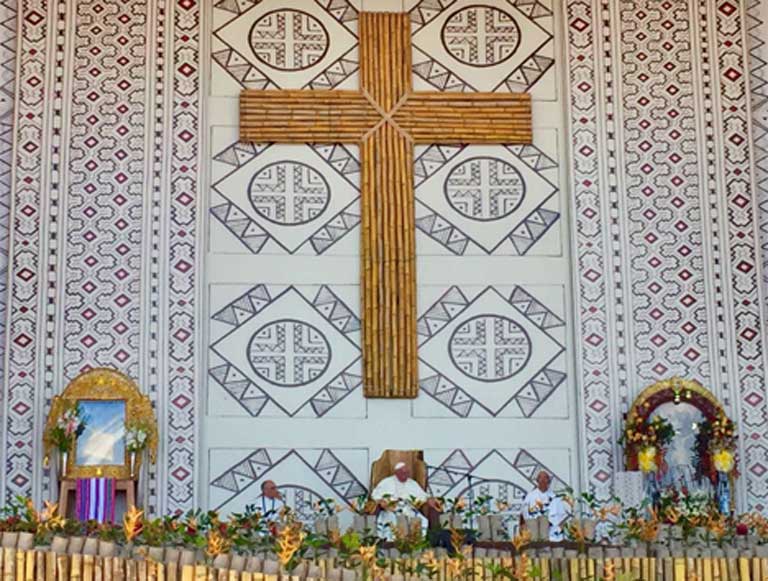- On 19 January, Pope Francis spoke to a crowd of thousands, including many indigenous people, in Puerto Maldonado, Peru, the capital of Madre de Dios state in the Amazon, a region that has seen significant deforestation (62,500 hectares between 2012 and 2016), and significant violence due to illegal mining.
- Latin American analysts, while excited about the pope’s visit, and appreciative of his spotlighting of illegal mining in Madre de Dios and other environmental problems across Amazonia, expressed doubt that the papal visit will have much impact in the long run.
- The pope singled out large corporations in his address: “[G]reat business interests… want to lay hands on [the Amazon’s] petroleum, gas, lumber, gold and other forms of agro-industrial monocultivation,” he said. “We have to break with the historical paradigm that views Amazonia as an inexhaustible source of supplies for other countries without concern for its inhabitants.”
- The pope invited a top-down and bottom-up response by Catholics to the Amazon crisis, calling on indigenous people “to shape the culture of local churches in Amazonia,” and announcing next year’s first-ever Synod for Amazonia – a gathering of global bishops who will put papal doctrine such as Laudato Si, his landmark 2015 papal encyclical, into action.

There is nothing quite so effective as an historic visit by a charismatic pope for bringing grave moral issues into the bright light of spiritual hope.
Pope Francis did just that on 19 January when he arrived in Puerto Maldonado, Peru, the capital of Madre de Dios state in the Amazon which is rich in biodiversity, but also in gold; nearly 62,500 hectares (154,440 acres) of forest were lost there to illegal gold mining between 2012 and 2016, an area bigger than ten Manhattan islands.
Nature isn’t the only victim of Illegal gold mining. The deforestation, violence and land conflicts, and toxic mercury pollution it brings to local rivers, are also seriously impacting indigenous communities who for centuries have laid claim to their ancestral rainforests and waterways.
“The native Amazonian peoples have probably never been so threatened on their own lands as they are at present,” Pope Francis said in a stirring address to a huge crowd that filled a sports arena and included many indigenous people dressed in their finest decorative robes and feathered-headdresses.
The pope didn’t only blame illegal small-scale miners for the Peruvian deforestation crisis. “Amazonia is being disputed on all fronts,” the pope said. “There is the pressure being exerted by great business interests that want to lay hands on its petroleum, gas, lumber, gold and other forms of agro-industrial monocultivation… We have to break with the historical paradigm that views Amazonia as an inexhaustible source of supplies for other countries without concern for its inhabitants.”
Judging by the ear-shattering waves of applause the pope received, everyone within earshot of Francis agreed with his assessment of the crisis and with his call to action.
“We Peruvians are obliged to take care of our cultural and natural heritage,” agreed Mariela Cánepa, policy director for the World Wildlife Fund-Peru, who hailed the pope for being forthright about the issue. “Now that this is out there in the open, we need to come together and work toward that goal [of curbing amazon deforestation]. Short term, we must make sure that this stays as a priority in the public agenda, besides plain or rhetorical statements. We need to commit to a more inclusive and sustainable vision for the Amazon and the country. Long term, everyone – authorities, civil society and citizens – need to be accountable.”

Now what?
The public moment of the pope’s visit has now passed. After speaking out passionately in Peru – pumping new life into the Laudato Si, his landmark 2015 papal encyclical that blasted capitalism and blamed humanity for climate change, while demanding global stewardship of “our common home” – the pope has returned to Rome.
Across the Amazon, it’s back to life as before the visit: back to chain saws. To mercury poisoning. To human and wildlife trafficking. To a relentless assault on a U.S-size region rich in natural resources, but on which the planet’s wellbeing depends for carbon sequestration, weather regulation, regional and global climate stability, and an array of plant, animal, bird and insect life found nowhere else.
The question analysts are asking is will hope take root in the wake of Francis’ visit?
Puerto Maldonado is the largest city in the state of Madre de Dios; its economy depends largely on illegal gold mining. Will the governor of Madre de Dios, Luis Otsuka, former head of the statewide miners’ association, become an environmentalist? Will the government in Lima take much needed steps to protect the indigenous tribes whom Pope Francis so exalted?
“The defense of the earth has no other purpose than the defense of life,” the pope asserted. “We know of the suffering caused for some of you by emissions of hydrocarbons, which gravely threaten the lives of your families and contaminate your natural environment.”
A consensus of those interviewed by Mongabay, as well as those quoted in other media, is pessimistic. Most offer little hope that government or business leaders will change much as a result. Many, for example, have long dismissed Laudato Si as naïve or beyond the pope’s expertise. Surprisingly, many of the working poor are opposed to the Pope’s environmental message, fearing that it will deprive them of jobs and an economically secure future.
Pedro Solano, executive director of the Lima-based Peruvian Society of Environmental Law, saw the pope Friday and spotted Governor Otsuka in the crowd.
He told Mongabay he did not expect Otsuka to suddenly press for a reduction in illegal gold mining. But he added, “It is good to remind people that he was in the audience and that his role is to act accordingly to the [environmental and indigenous] emergency… and in the public interest of the most valuable rights that are in jeopardy: human and environmental rights.”

Calling on church leaders
If the pope’s words are to lead to practical action, it may fall to the Catholic Church of South America to make it so, many agreed. But that, too, is complicated. The church is still staggering through its sexual abuse scandals, especially in Chile. While Francis, an Argentinian, remains popular, his South American cardinals and bishops are less so.
“I’m Catholic, I believe in God, but I’ve learned not to trust priests,” Edwin Vasquez, leader of an Amazon indigenous organization, told The New York Times.
Enrique Ortiz, a program manager with the Andes Amazon Fund and a Peruvian conservationist, is more optimistic. The pope’s specific call for the church to be more engaged in environmental protection and indigenous rights “is the real game changer,” he says.
“The pope is making sure that at the level of small, medium and large-scale churches, Laudato Si is coming. It’s real. It’s a big deal,” Ortiz told Mongabay. “Two years ago, we wondered if it would have any impact. But Francis is now telling the church, ‘This is a priority.’ It’s going to take a while, but it’s coming. Change always comes slowly to the Catholic Church.”
Frances Seymour, a senior fellow with World Resources Institute, agreed: “Papal attention can inspire, encourage and empower local religious leaders and faith communities to redouble their efforts to stave off forest destruction and violations of human rights.”

Manuel Pulgar-Vidal is the World Wildlife Fund’s director of climate and energy. As Peru’s former minister of the environment, he helped produce the working draft of the 2015 Paris Agreement at the 20th United Nations Climate Summit in Lima in 2014. He has long waited for Laudato Si to bring about change.
“There need to be priests who are capable of not only talking about the environment, but anchoring it in real issues,” he told The Washington Post. “This has not been done, which is why the message [of the encyclical] has not had the impact it should have.”
In Puerto Maldonado, Pope Francis made clear that he remains committed to expanding the mission of the Church to include earth stewardship. But he understands well that this change can’t only come from above. On his South America trip, he called on indigenous people “to shape the culture of local churches in Amazonia.”
Then he punched up his commitment: in Peru, the pontiff announced that he will convene the first-ever Synod for Amazonia next year – a gathering of global bishops who will aim to put papal doctrine such as Laudato Si into action on the ground – including in the rainforests across Amazonia.
Correction: Enrique Ortiz, is a program manager with the Andes Amazon Fund, not a project manager, as first reported.
Justin Catanoso is a regular contributor to Mongabay and a professor of journalism at Wake Forest University in North Carolina, USA. Follow him on Twitter @jcatanoso
FEEDBACK: Use this form to send a message to the author of this post. If you want to post a public comment, you can do that at the bottom of the page.
